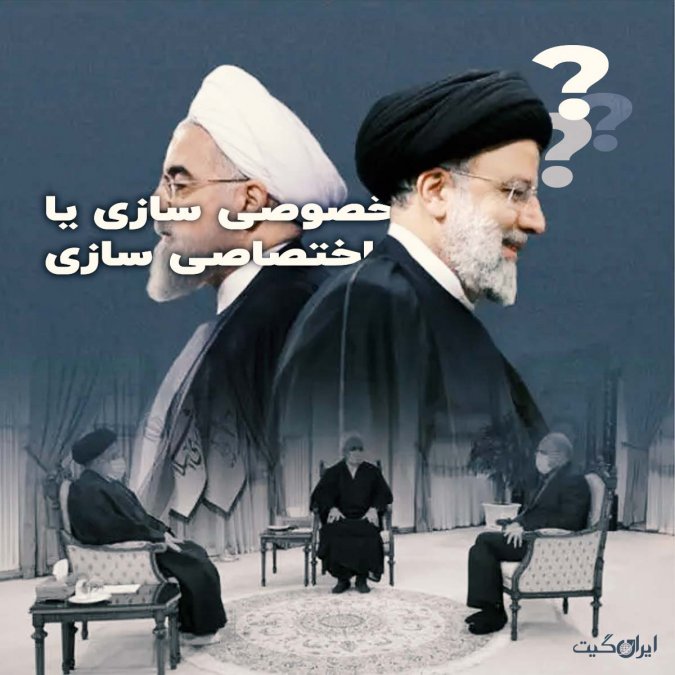Privatization or Customization
Privatization or customization, according to Iran Gate, a recent resolution was approved by the heads of the three branches, which has elicited reactions from many economic experts and activists in this field. According to this resolution, it has been decided that the government will sell, transfer, or lease assets and properties that essentially belong to all citizens of the country. Economists believe this action has been taken with the motive of addressing the budget deficit and compensating for the government’s imbalances, and it cannot truly be regarded as resource generation.
In the first part of the government’s resource generation plan review, the methods of budget deficit financing by governments were mentioned. The methods of obtaining these resources and the consequences of their use were also explained, which can be summarized as the government always dipping into the pockets of ordinary citizens to cover its deficits.
The simplest solution that can be available to any government is the mechanism of printing money or printing high-powered money, which ultimately leads to an intensified devaluation of the national currency. In the second part of this review, the details and consequences of the so-called resource generation plan in the country’s economy are discussed.
What does the government mean by resource generation?
Tasnim News Agency, which has been fully supportive of Ebrahim Raisi’s government and has passionately defended all the policies of the thirteenth cabinet, has provided an interesting and at the same time strange definition of the government’s resource generation plan. Tasnim writes in this regard that the concept of resource generation of government assets is for the government to identify unused assets or assets with low added value and productivity that have been abandoned for years and are not being used optimally, so these assets can be optimized.
Tasnim continues to write that resource generation of government assets has been experienced worldwide, and in many developed countries, efforts are made to make government assets productive. These assets are for current and future generations, and it is not as if we should feel that government assets are only for the current period. These assets, like oil, are intergenerational capital, and efforts should be made to use these assets optimally.
The phrases used by this pro-government news agency to promote the resource generation plan are exactly in line with the statements that Ebrahim Raisi has recently made in this regard. But do the claims the government has made about this plan and its attempt to make it seem natural have any basis in reality or not?
The government’s plan under scrutiny
As mentioned in the first part, this plan is being implemented with the aim of addressing the budget deficit by the government. In other words, the government has been unable to pay the salaries and benefits of its employees and cover its current expenses, and after tapping into the resources at the central bank’s disposal, now intends to sell public assets.
However, there are key points in this plan that have caused concern among economists and experts. Among these are the thought-provoking title of this plan. The term resource generation itself means that the government intends to transfer some of its assets to what it calls the private sector to benefit from the proceeds and also to relieve itself of the heavy burden of current expenses of these entities. Initially, this action seems logical given the sanctions the government is entangled with, but what is the reason for the protest and criticism from experts, economists, and even genuine private sector activists?
The reality is that in the more than 17 years since the approval of Article 44 on privatization in 2005, the government has proven that it has taken steps to elevate a class of stakeholders who have proven their loyalty to the regime. In reality, it can be said that what has been done in practice bears no resemblance to privatization and can practically be referred to as the customization of resources and assets under the government’s control.
The dark record of resource generation globally
Now there is fear that the resource generation plan may also be a supplement to the same Article 44, which resulted in major disasters in the context of Iran’s economy. Although privatization has also been implemented in countries that gained independence after the collapse of the Soviet Union, and in cases like the Czech Republic, Ukraine, and even East Germany, it was very successful, the same model in countries like Russia, Belarus, and Azerbaijan significantly led to the formation of an oligarchic class that still, more than 30 years after the collapse of the Soviet Union, either holds power directly or is influential and involved in the process of acquiring political power.
Deciphering with the help of global experience
Now it seems that what Raisi’s government intends to do under the code name of resource generation is the final and complementary step for the story of Article 44, with the difference that so far it has created a new and parvenu group called quasi-private entities. Companies that are neither government-owned nor belong to the weak and fragile private sector of Iran’s economy have been the winners of the game over the past 17 years. Now it is expected that with the approval of the government’s resource generation plan, a much firmer and longer step will be taken towards the fattening of quasi-private entities in Iran.
A step that could further increase the dominance of quasi-private entities over the country’s economy. In this case, the result would be nothing but the further weakening of the real economy, which is being turned by the genuine private sector. Corruption will also spread intensely, and many stakeholders will gain heavy and tempting profits from the process of transfer or what the government calls resource generation.

